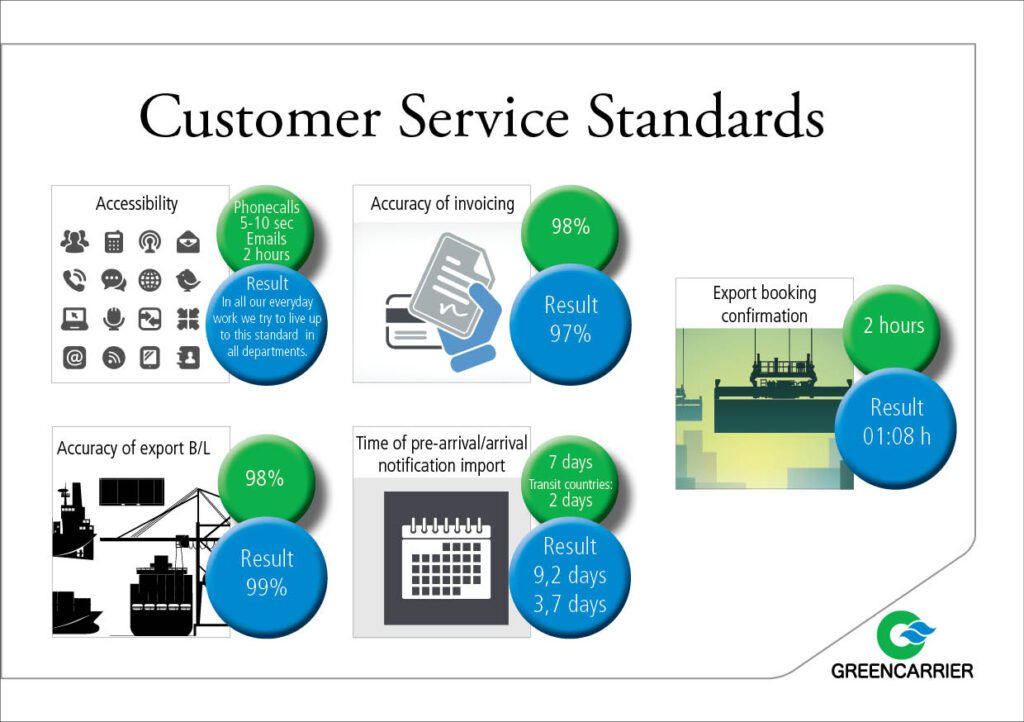
Do you remember a blog article that we wrote about a year ago, that described Greencarrier Liner Agency’s work with improving customer service standards? Well, as promised, we are now back a year later to follow up on the targets set up for each standard and the results from our measurements. Our customers are our top priority, and it is with their help that we can improve our business.
An extensive knowledge of our customers’ needs – Greencarrier’s main priority
During the year we have been working with a comprehensive project to develop our customer service standards within Greencarrier Liner Agency. We did a customer satisfaction survey in 2014 to find out how our customers perceived us and we received some good business reviews. But most importantly, we got great feedback on how to improve our business and what really matters for our customers when it comes down to everyday business. “Hard facts” like export booking confirmation, the time of arrival notification, the accuracy of export bill of lading and invoicing are factors that play a major role for our customers.
What we did in order to improve our customer service standards
We decided on five focus areas that we wanted to improve – our five Customer Service Standards. We defined goals for each standard, in order to improve our business and service.
- Accessibility. We always want to be reachable to our customers. We will answer phone calls within five to ten seconds and emails within two hours.
- Accuracy of export/import invoicing. We want our customers to always have confidence in our work and feel that the accuracy of export and import invoices are correct and processed in the right way. Our ambition is to have 98% accuracy of our invoicing.
- Export booking confirmation. We have the ambition to confirm bookings within two hours.
- Accuracy of export B/L. When sending B/L to customers we want these to always be correct with the right information. Our goal is to have 98% accuracy on the export B/L as well.
- Time of prearrival/arrival notice import. When sending our prearrival/arrival notice to our import customers our goal is to send this within seven days, and to our transit customer within two days.
We have been measuring our Customer Service Standards during a period of time and now we want to share the results with you! The results are based on all our seven countries’ customer service performances together. Each standard has been measured during a time period of one month. The illustration presents the results from this year’s measurements, where the green circles show our goals, and the blue circles reveal the results.
Valuation work – important for our development and improvement
To sum up our measurements, we can see in the results that our valuation work has succeeded in some areas, for example accuracy of export B/L and export booking confirmation. In some areas we still have improvements to do and we will continue our work in order to reach our goals. We constantly strive towards happy and satisfied customers and the development of our customer service is a job that we never consider to be finished.
As the business climate is changing and we’re moving towards a more rapid handling of systems and processes, the demands become higher as well as the pace. Therefore it is important for Greencarrier to stay updated and well equipped to meet our customer’s requirements and needs. Next year we will do another customer satisfaction survey. We welcome you to follow our development, and to keep an eye out for next year’s results!
What would you say is the most important part of customer service when it comes to logistics and transport companies? Do you think we live up to the market demands?
Feel free to leave a comment in the field below or interact with us in our social media channels. We’d love to know what you think!
/Tuomas Timgren, Greencarrier Liner Agency

